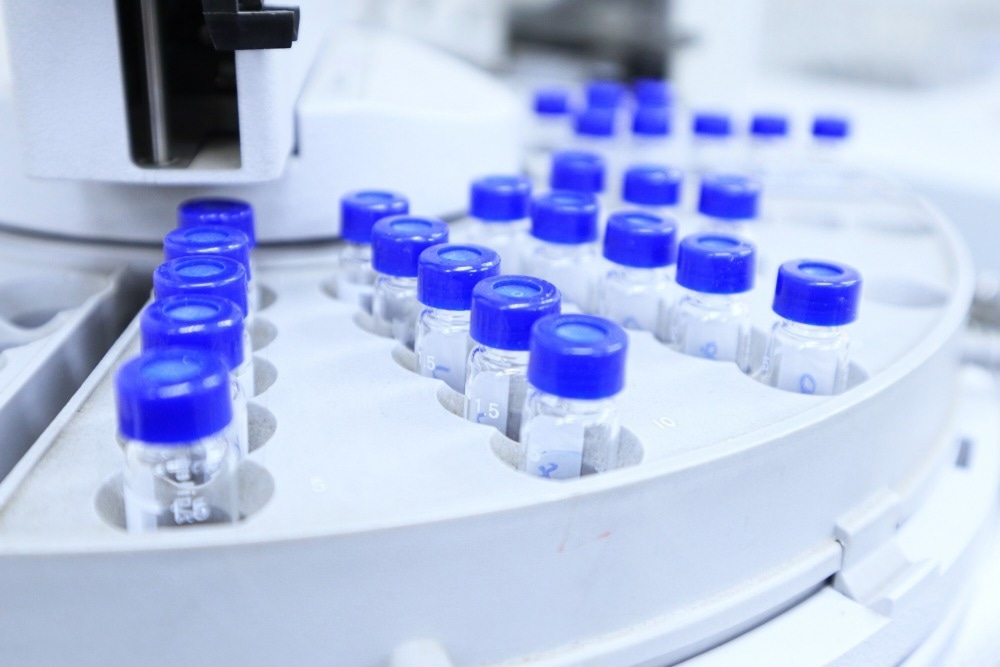In this article, AZoLifeSciences offers a complete guide to the working principle of multidimensional chromatography and its applications to the life sciences.

Image Credit: hotsum/Shutterstock.com
What is Chromatography?
Chromatography is a method of separation wherein the mixture is dissolved in a gas or liquid (the mobile phase) and passed through a separating column (the stationary phase) with which the expected components of the mixture will interact to differing degrees. This causes some components of the mixture to pass through the column more quickly or slowly and allows pure isolated compounds to be collected. Multidimensional chromatography utilizes two or more separation stages, generating significantly improved separation between components that would otherwise elute with significant overlap.
Why is Multidimensional Chromatography Used?
Typical stationary phases can separate the components of mixtures via a number of physical and chemical interactions, such as size (size exclusion chromatography), charge (ion exchange chromatography), hydrophobicity (hydrophobic interaction chromatography), or other complex properties.
By stacking two separating columns selecting for differing properties, many compounds otherwise indistinguishable for one-dimensional chromatography can be separated.
For example, many biomolecules such as proteins, peptides, nucleic acids, and important disease biomarkers are very similar in size, charge, and hydrophobicity to other molecules within their class, and thus by combining two or more types of stationary phase in sequence, they can firstly be separated by size, then by charge, for example.
Similarly, many drug metabolites are highly similar, and petroleum oil mixtures contain a large number of molecules of similar but slightly variable structure, and thus multidimensional chromatography has found application in both the health and energy fields.
How is the Analyte Passed Between Columns?
Multidimensional chromatography systems have been established between gas chromatography-gas chromatography (GC-GC) and liquid chromatography-liquid chromatography (LC-LC) systems, which utilize specially designed gates and pumps that allow flow in only one direction, and are capable of redirecting and releasing certain substances before allowing the analyte entry into the second column.
The apparatus between columns that controls this is termed a modulator, of which there are several forms, the selection depending on the analytes in question and the solvents in use. One of the oldest and simplest methods of transfer is termed heart-cutting, wherein the interface is initially closed until the eluting analyte reaches the end of the first column, whereupon the gate is briefly opened to allow the analyte into the second. Unfortunately, much of the separation between analytes, and thus resolution, achieved within the first column is lost during the heart-cutting process, particularly within GC-GC systems, though it can be re-achieved during elution through the second column.
More modern modulators can automatically transfer analytes from the first to the second column while maintaining resolution, keeping the ‘modulation period’ the same length of time as the width between elution peaks. A device known as a Deans switch is frequently incorporated into multidimensional chromatography setups, which can actively direct eluent as it leaves the first column towards the second, or alternatively out of a waste outlet or directly into a detector. A pneumatic control module is typically employed to monitor and control flow through the Deans switch.
Multidimensional chromatography has also been performed in LC-GC systems, wherein a liquid mobile phase is converted to gas before entry into the second column. Heated and pressurized inlets are used to vaporize the liquid effluent, though this may cause some issues relating to the injection of polar solvents such as water into non-polar GC columns, and thus LC-GC setups require careful planning.
Furthermore, the time required for vaporization may cause a delay in entry to the second column, and a loss of resolution as a result. This is usually circumvented by utilizing a much faster second-dimension separation than the first in all types of multidimensional chromatography. However, this difference is notably lesser in LC-GC systems.
For example, a typical GC-GC setup may have first-phase elution times in the order of minutes and a second phase elution time of only seconds, while LC-GC systems usually take several minutes in each phase. HPLC flow can be halted or slowed while effluent passes through the second column, though this may cause band broadening and loss of resolution.
Applying Multidimensional Chromatography to the Life Sciences
Multidimensional chromatography has emerged as a key strategy in the separation of many complex mixtures for analysis of their components, such as food, drugs, minerals, and biological samples. For example, many flavorings and fragrances contain chiral compounds that present significantly overlapping peaks, and can be better separated using GC-GC systems.
Similarly, trace compounds can be better distinguished from similar ones in much greater concentration using multidimensional chromatography down to a limit of around 0.1 g/L, and LC-LC systems have been used to quantify complex B vitamins in food, lemonin in grapefruit peel, malthion (an insecticide) in tomato plants, and other low concentration components.
Environmental analysis extensively utilizes multidimensional chromatography to detect complex and trace organic pollutants such as pesticides, polycyclic aromatic hydrocarbons, and halogenatic chemicals in all types of samples, such as air, water, or soil.
The ability to separate trace organic compounds from large and complex mixtures is also highly valued in forensics, where evidence of sickness and poison, for example, must be detected in all manner of tissues and bodily fluids. GC-GC is particularly employed in the detection of drugs, while LC-LC is used in the analysis of biological matrices. LC-GC has been used in the analysis of biological samples such as plasma and tissues for toxic compounds.
Sources
Seeley, J. V., & Seeley, S. K. (2013). Multidimensional Gas Chromatography: Fundamental Advances and New Applications. Analytical Chemistry, 85(2), pp.557–578. doi.org/10.1021/ac303195u
Amin, R., et al. (2022). Multidimensional Chromatography and Its Applications in Food Products, Biological Samples and Toxin Products: A Comprehensive Review. Separations, 9(11). p.326. doi.org/10.3390/separations9110326
Shah, P. A, et al. (2021). Multidimensional chromatography platforms: status and prospects. Bioanalysis, 13(14). doi.org/10.4155/bio-2021-0118
Further Reading
Last Updated: Aug 24, 2023